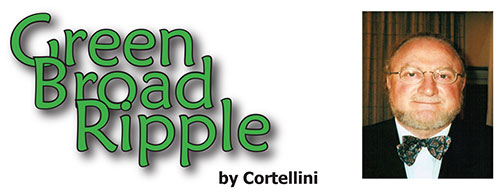
|
Broad Ripple Random Ripplings

The news from Broad Ripple
Brought to you by The Broad Ripple Gazette
(Delivering the news since 2004, every two weeks)

|
| Brought to you by: |

|

|

|

|

|

|
Converted from paper version of the Broad Ripple Gazette (v04n20)
Green Broad Ripple - Is Grass Green? - by Cortellini
posted: Oct. 05, 2007

Is Grass Green?
Earlier this week I attended a meeting of the Indiana Chapter of the US Green Building Council. I had the opportunity to ask a question of one of the presenters who was relating all the green efforts his company was initiating. "Have you considered getting rid of lawns?" I have spoken on this subject before in this column yet I recently ran across a most relevant passage in a book written by Heather C. Flores, "Food not Lawns," that does such a good job on the subject that I herewith quote her liberally.
"French aristocrats popularized the idea of the green, grassy lawn in the eighteenth century when they planted the agricultural fields around their estates to grass to send the message that they had more land than they needed and could therefore afford to waste some. Meanwhile French peasants starved for lack of available farmland, and the resulting frustration might well have had something to do with the French Revolution in 1789."
Today fifty-eight million Americans spend approximately thirty billion dollars every year to maintain more than twenty-three million acres of lawn. That's an average of over a third of an acre and $517 each. The same-sized plot of land could still have a small lawn for recreation and produce all the vegetables needed to feed a family of six. The lawns in the United States consume around 270 billion gallons of water a week-enough to water eighty-one million acres of organic vegetables, all summer long. Lawns use ten times as many chemicals per acre as industrial farmland. These pesticides, fertilizers, and herbicides run off into our groundwater and evaporate into our air, causing widespread pollution and global warming, and greatly increasing our risk of cancer, heart disease, and birth defects. In addition, the pollution emitted from a power mower in just one hour is equal to the amount from a car being driven 350 miles. In fact, lawns use more equipment, labor, fuel, and agricultural toxins than industrial farming, making lawns the largest agricultural sector in the United States. But it's not just the residential lawns that are wasted on grass. There are around seven hundred thousand athletic grounds and 14,500 golf courses in the United States, many of which used to be fertile, productive farmland that was lost to developers when the local markets bottomed out."
"These huge numbers are somewhat overwhelming, if not completely incomprehensible, but they make the point that lawns not only are a highly inefficient use of space, water, and money but also are seriously contributing to the rapid degradation of our natural environment."
"If we truly feel committed to treating the earth and one another with equality and respect, the first place to show it is by how we treat the land we live on. It is time to grow food, not lawns! The reasons include reducing pollution, improving the quality of your diet, increasing local food security, and beautifying your surroundings, as well as building community and improving your mental and physical health. You will save money and enhance your connection with the earth and with your family."
"If we can change our land use philosophy from one of ownership and control to one of sharing and cooperation, we can renew our connection with the earth and one another and thus benefit through increased physical and mental health, an improved natural environment, and stronger local communities. What have you got to lose besides a few blades of grass?"
Heather certainly makes a compelling argument for the case that grass is not Green but also that lawns may be an artificial and wasteful extravagance we can no longer afford.
Cortellini is a licensed architect in the states of Indiana and Arizona. He holds a BFA from Indiana University Herron School of Art. He has taught architectural technology at the college level at several universities and has pursued independent artistic endeavors. His architectural practice has focused on residential and small commercial projects. He has recently committed his practice to designing Green buildings, is a member of the US Green Building Council and is a LEED Accredited Professional. Send questions/comments to cortellini@BroadRippleGazette.com
cortellini@broadripplegazette.com

|

|

|
| Brought to you by: |

|

|

|
| Brought to you by: |

|

|

|


